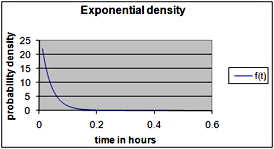Chapter 57: The Poisson and Exponential Random Variable
Overview
-
What is the Poisson random variable?
-
How do I compute probabilities for the Poisson random variable?
-
If the number of customers arriving at a bank is governed by a Poisson random variable, what random variable governs the time between arrivals?
-
What is the Poisson random variable?
-
The Poisson random variable is a discrete random variable that is useful for describing probabilities for situations in which events (such as customer arrivals at a bank or orders placed for a product) have a small probability of occurring during a small time interval. More specifically, during a small time interval, denoted as t, either zero or one event will occur, and the probability of one event occurring during a small interval of length t is (for some λ) given by λt. Here, λ is the mean number of occurrences per time unit.
-
Situations in which the Poisson random variable can be applied include the following:
-
Number of units of a product demanded during a month
-
Number of deaths per year by horse kick in Prussian army
-
Number of car accidents you have during a year
-
Number of copies of The Seat of the Soul ordered today at Amazon.com
-
Number of workers’ compensation claims filed at a company this month
-
Number of defects in 100 yards of string. (Here, 1 yard of string plays the role of time.)
-
-
How do I compute probabilities for the Poisson random variable?
-
You can use the Microsoft Office Excel 2007 POISSON function to compute probabilities involving the Poisson random variable. Just remember that in a length of time t, the mean of a Poisson random variable is t. The syntax of the POISSON function is as follows:
-
POISSON(x,Lambda,True) calculates the probability that a Poisson random variable with a mean equal to Lambda is less than or equal to x.
-
POISSON(x,Lambda,False) calculates the probability that a Poisson random variable with a mean equal to Lambda is equal to x.
-
-
Here are some examples of how to compute probabilities for Poisson random variables. You can find these examples in the file Poisson.xlsx, shown in Figure 57-1.

Figure 57-1: Using the Poisson random variable -
Suppose that my consulting business receives an average of 30 phone calls per hour. During a two-hour period, I want to determine the following:
-
Probability that exactly 60 calls will be received in the next two hours
-
Probability that the number of calls received in the next two hours will be fewer than or equal to 60
-
Probability that from 50 through 100 calls will be received in the next two hours
-
-
During a two-hour period, the mean number of calls is 60. In cell C4, we find the probability (0.05) that exactly 60 calls will be received in the next two hours by using the formula POISSON(60,C2,FALSE). In cell C5, we find the probability (0.53) that, at most, 60 calls will be received in two hours with the formula POISSON(60,C2,TRUE). In cell C6, we find the probability (0.915) that from 50 through 100 calls will be received in two hours with the formula POISSON(100,C2,TRUE)–POISSON(49,C2,TRUE). Note that we can always use a “1” instead of “TRUE” as an argument in any Excel function.
-
If the number of customers arriving at a bank is governed by a Poisson random variable, what random variable governs the time between arrivals?
-
The time between arrivals can be any value, which means that the time between arrivals is a continuous random variable. If an average of arrivals occur per time unit, the time between arrivals follows an exponential random variable having the probability density function (pdf) of f(t)=λe-λt,t≥0. This random variable has a mean, or average, value equal to 1/λ. For λ=30, a graph of the exponential pdf is shown in Figure 57-2. You can find this chart and the data for this example in the file Exponentialdist.xlsx.

Figure 57-2: Exponential pdf -
Recall from Chapter 55, “An Introduction to Random Variables,” that for a continuous random variable, the height of the pdf for a number x reflects the likelihood that the random variable assumes a value near x. Thus, we see in Figure 57-2 that extremely short times between bank arrivals (for example, less than 0.05 hours) are very likely, but that for longer times, the pdf drops off sharply.
-
Even though the average time between arrivals is 1/30=0.033 hours, there’s a reasonable chance that the time between arrivals will be as much as 0.20 hours. The Excel formula EXPONDIST(x,1/mean,TRUE) will give the probability that an exponential random variable with a given mean will assume a value less than or equal to x. Thus, the second argument to the EXPONDIST function is the rate per time unit at which events occur. For example, to compute the probability that the time between arrivals is at least 5, 10, or 15 minutes, I copied from cell D5 to D7 the formula 1–EXPONDIST(C5,$D$2,TRUE).
-
Note that I first converted minutes to hours (5 minutes equals 1/12 hour, and so on). Also, the mean time between arrivals is 0.033 hours, so I entered into our formula 1/Mean=1/.033=30. In short, I entered the arrival rate per time unit, as you can see in Figure 57-3.
Figure 57-3: Computations of exponential probabilities
EAN: 2147483647
Pages: 200